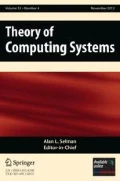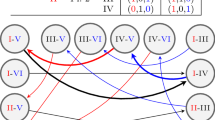Abstract
Fictitious play is a simple learning algorithm for strategic games that proceeds in rounds. In each round, the players play a best response to a mixed strategy that is given by the empirical frequencies of actions played in previous rounds. There is a close relationship between fictitious play and the Nash equilibria of a game: if the empirical frequencies of fictitious play converge to a strategy profile, this strategy profile is a Nash equilibrium. While fictitious play does not converge in general, it is known to do so for certain restricted classes of games, such as constant-sum games, non-degenerate 2×n games, and potential games. We study the rate of convergence of fictitious play and show that, in all the classes of games mentioned above, fictitious play may require an exponential number of rounds (in the size of the representation of the game) before some equilibrium action is eventually played. In particular, we show the above statement for symmetric constant-sum win-lose-tie games.



Similar content being viewed by others
Notes
A two-player game with totally ordered sets of actions is said to have strategic complementarities if the advantage of switching to a higher action, according to the ordering, increases when the opponent chooses a higher action, and diminishing returns if the advantage of increasing one’s action is decreasing.
The proof of this claim later turned out to be flawed [5].
References
Bellman, R.: On a new iterative algorithm for finding the solutions of games and linear programming problems. Research Memorandum P-473, The RAND Corporation (1953)
Berger, U.: Fictitious play in 2×n games. J. Econ. Theory 120, 139–154 (2005)
Berger, U.: Brown’s original fictitious play. J. Econ. Theory 135, 572–578 (2007)
Berger, U.: Learning in games with strategic complementarities revisited. J. Econ. Theory 143, 292–301 (2008)
Berger, U.: The convergence of fictitious play in games with strategic complementarities: a comment. MPRA Paper No. 20241, Munich Personal RePEc Archive, 2009
Brandt, F., Fischer, F.: On the hardness and existence of quasi-strict equilibria. In: Monien, B., Schroeder, U.-P. (eds.) Proceedings of the 1st International Symposium on Algorithmic Game Theory. Lecture Notes in Computer Science, vol. 4997, pp. 291–302. Springer, Berlin (2008)
Brown, G.W.: Iterative solutions of games by fictitious play. In: Koopmans, T.C. (ed.) Activity Analysis of Production and Allocation, pp. 374–376. Wiley, New York (1951)
Conitzer, V.: Approximation guarantees for fictitious play. In: Proceedings of the 47th Annual Allerton Conference on Communication, Control, and Computing, pp. 636–643 (2009)
Conitzer, V., Sandholm, T.: AWESOME: a general multiagent learning algorithm that converges in self-play and learns a best response against stationary opponents. Mach. Learn. 67(1–2), 23–43 (2007)
Dantzig, G.B.: A proof of the equivalence of the programming problem and the game problem. In: Koopmans, T.C. (ed.) Activity Analysis of Production and Allocation, pp. 330–335. Wiley, New York (1951)
Fudenberg, D., Levine, D.: Consistency and cautious fictitious play. J. Econ. Dyn. Control 19, 1065–1089 (1995)
Ganzfried, S., Sandholm, T.: Computing an approximate jam/fold equilibrium for 3-player no-limit Texas Hold’em tournaments. In: Proceedings of the 7th International Joint Conference on Autonomous Agents and Multi-Agent Systems, pp. 919–925 (2008)
Gjerstad, S.: The rate of convergence of continuous fictitious play. J. Econ. Theory 7, 161–178 (1996)
Goldberg, P.W., Savani, R., Sørensen, T.B., Ventre, C.: On the approximation performance of fictitious play in finite games. Int. J. Game Theory (2013). doi:10.1007/s00182-012-0362-6
Hahn, S.: The convergence of fictitious play in 3×3 games with strategic complementarities. Econ. Lett. 64, 57–60 (1999)
Hannan, J.: Approximation to Bayes risk in repeated plays. In: Dresher, M., Tucker, A.W., Wolfe, P. (eds.) Contributions to the Theory of Games, vol. 3, pp. 97–139. Princeton University Press, Princeton (1957)
Karlin, S.: Mathematical Methods and Theory in Games, Programming, and Economics, vol. 1–2. Addison-Wesley, Reading (1959)
Luce, R.D., Raiffa, H.: Games and Decisions: Introduction and Critical Survey. Wiley, New York (1957)
Miyasawa, K.: On the convergence of the learning process in a 2×2 nonzero sum two-person game. Research Memorandum 33, Econometric Research Program, Princeton University, 1961
Monderer, D., Sela, A.: A 2×2 game without the fictitious play property. Games Econ. Behav. 14, 144–148 (1996)
Monderer, D., Shapley, L.S.: Potential games. Games Econ. Behav. 14(1), 124–143 (1996)
Monderer, D., Shapley, L.S.: Fictitious play property for games with identical interests. J. Econ. Theory 68, 258–265 (1996)
Nachbar, J.H.: “Evolutionary” selection dynamics in games: convergence and limit properties. Int. J. Game Theory 19, 59–89 (1990)
Powers, R., Shoham, Y.: New criteria and a new algorithm for learning in multi-agent systems. In: Advances in Neural Information Processing Systems 17, pp. 1089–1096. MIT Press, Cambridge (2004)
Rabinovich, Z., Gerding, E., Polukarov, M., Jennings, N.R.: Generalised fictitious play for a continuum of anonymous players. In: Proceedings of the 21st International Joint Conference on Artificial Intelligence, pp. 245–250 (2009)
Robinson, J.: An iterative method of solving a game. Ann. Math. 54(2), 296–301 (1951)
Shapiro, H.: Note on a computation model in the theory of games. Commun. Pure Appl. Math. 11, 587–593 (1958)
Shapley, L.: Some topics in two-person games. In: Dresher, M., Shapley, L.S., Tucker, A.W. (eds.) Advances in Game Theory. Annals of Mathematics Studies, vol. 52, pp. 1–29. Princeton University Press, Princeton (1964)
von Neumann, J.: Zur Theorie der Gesellschaftspiele. Math. Ann. 100, 295–320 (1928)
von Neumann, J.: A numerical method to determine optimum strategy. Nav. Res. Logist. Q. 1(2), 109–115 (1954)
Zhu, W., Wurman, P.R.: Structural leverage and fictitious play in sequential auctions. In: Proceedings of the 18th National Conference on Artificial Intelligence, pp. 385–390 (2002)
Acknowledgements
This material is based on work supported by the Deutsche Forschungsgemeinschaft under grants BR 2312/3-2, BR 2312/3-3, BR 2312/7-1, and FI 1664/1-1, and by the European Research Council under Advanced Grant 291528. The authors would like to thank Vincent Conitzer, Paul Goldberg, Peter Bro Miltersen, and Troels Bjerre Sørensen for valuable discussions.
Author information
Authors and Affiliations
Corresponding author
Rights and permissions
About this article
Cite this article
Brandt, F., Fischer, F. & Harrenstein, P. On the Rate of Convergence of Fictitious Play. Theory Comput Syst 53, 41–52 (2013). https://doi.org/10.1007/s00224-013-9460-5
Published:
Issue Date:
DOI: https://doi.org/10.1007/s00224-013-9460-5




